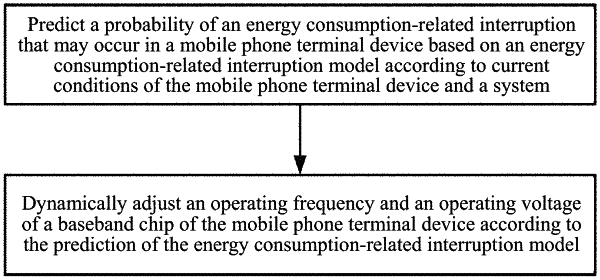| CPC H04W 52/029 (2013.01) [G06F 17/18 (2013.01)] | 5 Claims |

|
1. A method for optimizing a mobile phone terminal based on a probability of an energy consumption-related interruption, comprising:
S1. predicting a probability of an energy consumption-related interruption in real time, wherein the energy consumption-related interruption refers to that when a surface temperature of the mobile phone terminal exceeds a lowest temperature that can cause a burn on human skin, a baseband chip of the mobile phone terminal reduces computing capabilities of the mobile phone terminal to reduce a heat generation amount of the mobile phone terminal and the surface temperature of the mobile phone terminal, when the baseband chip has no redundant computing resources for data processing, a performance of a mobile communication system becomes unacceptable, and eventually leads to the energy consumption-related interruption; and
S2. adjusting an operating frequency of the baseband chip of the mobile phone terminal according to the predicted probability of an energy consumption-related interruption;
wherein step S2 comprises:
if a current probability of an energy consumption-related interruption is greater than or equal to 90%, adjusting the operating frequency of the baseband chip to 50% of a current frequency;
if the current probability of an energy consumption-related interruption is greater than or equal to 80% and less than 90%, adjusting the operating frequency of the baseband chip to 60% of the current frequency;
if the current probability of an energy consumption-related interruption is greater than or equal to 70% and less than 80%, adjusting the operating frequency of the baseband chip to 70% of the current frequency;
if the current probability of an energy consumption-related interruption is greater than or equal to 60% and less than 70%, adjusting the operating frequency of the baseband chip to 80% of the current frequency;
if the current probability of an energy consumption-related interruption is greater than or equal to 50% and less than 60%, adjusting the operating frequency of the baseband chip to 90% of the current frequency; and
making no adjustment in other cases,
wherein the probability of an energy consumption-related interruption is predicted by using an energy consumption-related interruption probability model in step S1, and the energy consumption-related interruption probability model is as follows:
 wherein
 wherein pout[ ] represents the probability of an energy consumption-related interruption, P[ ] represents a probability of occurrence of an event in the square brackets, d represents a symbol d in integral calculus, t represents a communication duration, Tsur(t) represents the temperature of the rear cover of the mobile phone, Tsafe represents a maximum temperature to avoid a burn on human skin, erf[ ] represents a Gaussian error function, μ represents an expectation in the Gaussian error function, θ represents a standard deviation in the Gaussian error function, Fbit represents a quantity of CPU cycles required for processing each bit of data, α represents a shape parameter, β represents a scale parameter, X(Fbit, t) represents a function related to Fbit and t, Γ(α) represents a Gamma function, B represents a bandwidth, F0 represents a fan-out factor of the baseband chip, ω represents an activation factor of a transistor in the baseband chip, Et represents switching energy consumption of a single transistor in the baseband chip, KBB represents a quantity of logical operations required for processing each bit of information in a baseband processing algorithm, Ntr represents a quantity of transistors in the baseband chip, hair represents an air convective heat transfer coefficient, A represents an area of a heat sink, Tsur0 represents an initial temperature of the rear cover, z represents a thermal conductivity, cchip represents a specific heat of the baseband chip, m represents a mass of the baseband chip, λ represents a ratio of heat transferred from a downlink low-noise amplifier and an uplink power amplifier to the baseband chip, and QAM represents a heat generation power of the low-noise amplifier and the power amplifier.
|